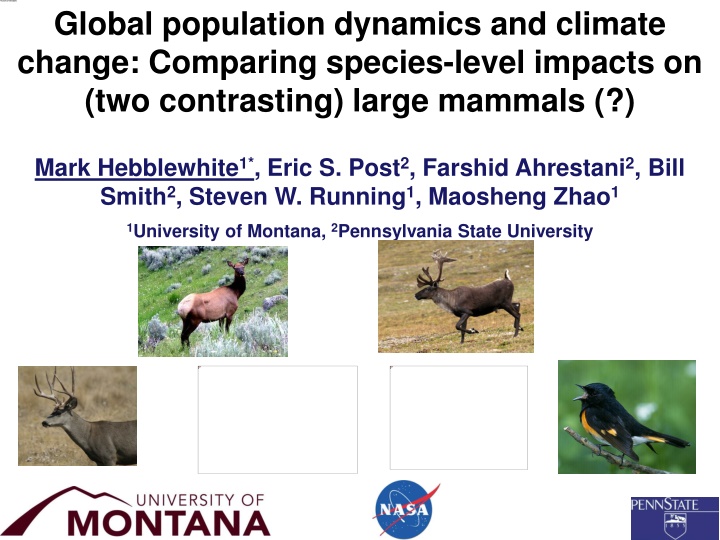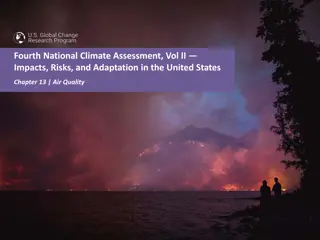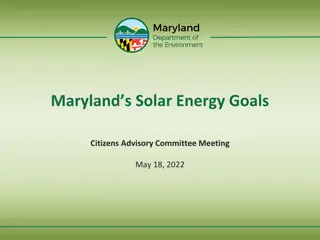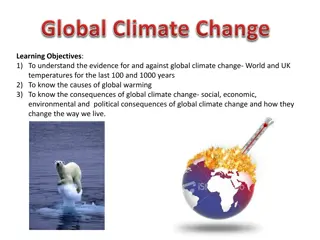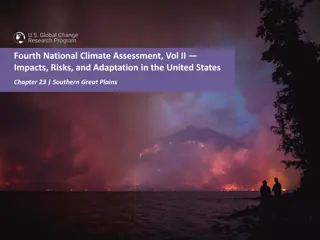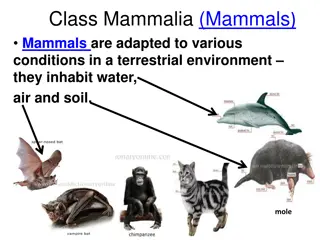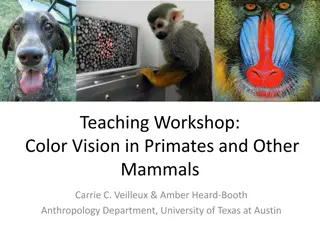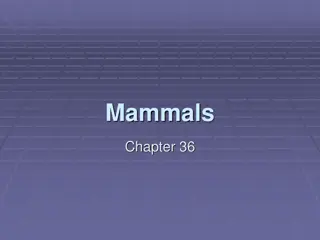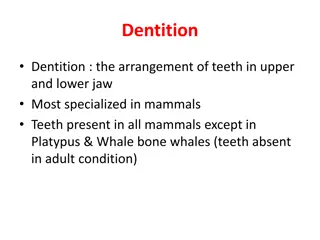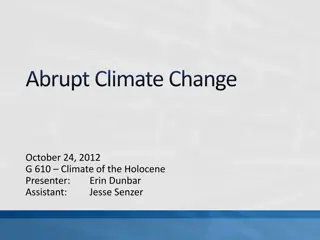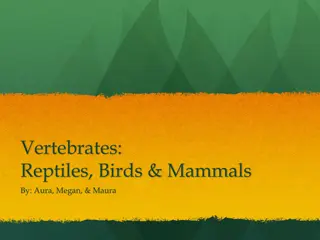Impacts of Global Population Dynamics and Climate Change on Large Mammals
This study by Mark Hebblewhite and colleagues compares the species-level impacts of global population dynamics and climate change on two contrasting large mammals. The research, led by Hebblewhite, Post, and Ahrestani, emphasizes the importance of understanding how these factors affect the survival and behavior of large mammal species. The findings highlight the intricate relationship between population dynamics, climate change, and the well-being of wildlife in a rapidly changing world.
Download Presentation

Please find below an Image/Link to download the presentation.
The content on the website is provided AS IS for your information and personal use only. It may not be sold, licensed, or shared on other websites without obtaining consent from the author.If you encounter any issues during the download, it is possible that the publisher has removed the file from their server.
You are allowed to download the files provided on this website for personal or commercial use, subject to the condition that they are used lawfully. All files are the property of their respective owners.
The content on the website is provided AS IS for your information and personal use only. It may not be sold, licensed, or shared on other websites without obtaining consent from the author.
E N D
Presentation Transcript
Global population dynamics and climate change: Comparing species-level impacts on (two contrasting) large mammals (?) Mark Hebblewhite1*, Eric S. Post2, Farshid Ahrestani2, Bill Smith2, Steven W. Running1, Maosheng Zhao1 1University of Montana, 2Pennsylvania State University
Global population dynamics and climate change: Comparing species-level impacts on (two contrasting) large mammals Question: How does climatic influence vary across a species range and globally after accounting for biotic interactions? Approach: Global Population Dynamics Approach (Post et al. 2009, Bioscience) Methods: Niche Modeling with climate, landuse, fire Population dynamics models using time series models with climate , vegetation indices, biotic interactions Link population and niche models at species range scale
Outline 1.Summary of work on Rangifer and Cervus dynamics Strengths and limitations of time- series of N? 2. Mule Deer Functional PCA of NDVI and climate 3. Elk time-series of survival and recruitment 4. Summary
Cervus elephas Ahrestani et al. (2013) Scientific Reports
Time Series Data 2 Caribou time-series data quite noisy
Time-Series Conclusions The most stable dynamics were observed in populations experiencing: negative trends in the variation in vegetation productivity (declining NDVI) positive departures from long-term mean annual temperature (later springs, shorter growing season) The most UNSTABLE population dynamics were observed in populations experiencing: Increasing trends in vegetation productivity (increasing NDVI) Negative departures from long-term mean annual temperatures (earlier springs, shorter growing season)
Time-Series Conclusions Utility of wildlife time-series data at broad spatial scales is challenging E.g., caribou poor precision, high uncertainty in counts being meaningful Some species higher quality currently examining trends in spatial autocorrelation in climate drivers using BBS bird data Ability to understand mechanism of how climate impacts driving population dynamics are limited. Move to a population modelling approach
Outline 1.Summary of work on Rangifer and Cervus dynamics Strengths and limitations of time- series of N? 2. Mule Deer Functional PCA of NDVI and climate 3. Elk time-series of survival and recruitment 4. Birds - trends in autocorrelation of population trends
Mule Deer & Global Change 1.Time-series of demographic traits moving beyond time-series data 2.Mule deer overwinter survival a key demographic trait of mule deer 3.Semi-arid systems Fall phenology more variable? How does climate and NDVI drive overwinter survival? 4.Can we use NDVI to predict population dynamics?
Mule Deer & Global Change 1. Time-series of demographic traits moving beyond time- series data 2. Mule deer overwinter survival a key demographic trait of mule deer
Functional PCA 1. Most analyses of NDVI use summary statistics; mean, SD, etc. in animal ecology studies 2. TIMESAT extracts beginning, end, peak, etc. all correlated 3. Standard PCA ignores temporal component of NDVI data equivalent to assuming weeks (MODIS periods) are independent 4. Developed novel application of Functional PCA to NDVI data
Functional PCA 1. FPCA is a form of Functional Data Analysis (Ramsay & Silverman 2005, Ramsay et al. 2009) 2. Few ecological or remote sensing examples? (Embling et al. 2012) 3. Three main steps: 1) Definition of the basis functions, 2) Smoothing of the observed curves, and 3) Summarizing the variation in the curves. Ramsay R, Silverman BW. 2005 Functional data analysis. New York, NY: Springer. Ramsay JO, Hooker G, Graves S. 2009 Functional data analysis with R and MATLAB. New York, NY: Springer. Embling CB, et al. 2012. J. Appl. Ecol. 49, 481 492.
Functional PCA Code & sample data for FPCA available on PTRSB special issue Email corresponding author or myself
Mule Deer Study Area 1. Idaho, 1998 2011 2. Thirteen Game Management Units (GMU s) spanning a wide geographic gradient of 160,000km2 3. Annual variation in population dynamics driven by overwinter fawn survival 4. 2,315 mule deer fawns captured in late Fall/Early Winter 5. MODIS NDVI, EVI, Snow cover 6. PRISM weather data
Mule Deer & Global Change 1.FPCA an important advance in how to extract information from the entire NDVI curve 2.Identified regions in which FALL versus SPRING phenology was the primary driver of overwinter survival 3.AREAS and SEASONS with the greatest temporal variance in phenology drove overwinter survival
Harvest Season Setting for year t+1 (Jan 1) Overwinter survival Winter in year t (Nov - Dec) Recruitment into year t+1 (May) MODIS Snow Fall senescence in year t (Sept) Fawn birth and spring green up in year t Summer (neonate survival) Remote Sensing Data (NDVI, PCA1) Remote Sensing Data (NDVI, PCA2)
Mule Deer Population Dynamics 1. Bayesian Integrated Population Models build off state-space time-series models we developed for elk and caribou 2. Allow prediction in time and space with missing data (e.g., some units only have N, some fawn:doe ratio, etc) 3. Provide a framework for wildlife managers to incorporate effects of variation in climate (PRISM) and NDVI (MODIS) on population management
Elk Population Dynamics 1. Collect adult female elk survival and calf recruitment data across the Northwestern USA 2. Western Elk Research Collaborative (WERC) - ID, MT, WY, OR, CO, WA, UT 4. USGS Coop unit funding key 5. Across our 45 study populations, we had data from 2746 individual adult female elk representing 9409 elk-years, with 1058 mortalities.
Elk Population Dynamics 1. Adult female elk survival does not vary that much 2. Relatively insensitive to variation in summer growing season conditions 3. Much more sensitive to variation in winter climatic conditions. 4. Wolf X Winter severity interaction.
Elk Population Dynamics 1. Juvenile recruitment key to ungulate population dynamics 2. WERC lead 3. Calf:cow ratio - 23 years 1989 - 2012 - 101 elk management units - 1,512 unit-years 4. Climate (PRISM) and NDVI (growing season conditions)
Elk Population Dynamics Lukacs et al. (2015) In Review, J. Applied Ecology
Elk Population Dynamics 1. Juvenile recruitment MUCH more sensitive to variation in: a. Climate (winter severity and summer precipitation) b. NDVI measures of forage biomass and variation c. Effects varied geographically across range of elk d. Next steps IPM for elk
Summary 1. Large mammal time-series data is challenging to link mechanistically to climate drivers - e.g. caribou - Birds? 2. State wildlife agencies often collect higher quality data than N, yielding more mechanistic insights into abiotic/biotic drivers 3. Final results to come! - NDVI forage quality from Idaho to Greenland
Publications 1. Ahrestani, F. S., W. K. Smith, M. Hebblewhite, S. W. Running, and E. Post. 2015. Density dependence and population stability at the species distribution scale. Oikos In Revision. 2. Ahrestani, F. S., P. S. Jorgenson, M. Hebblewhite, and E. Post. 2015. Temporal trends in the scale of spatial autocorrelation A new frontier in monitoring population response to regional-level environmental change. Ecography In Review. 3. Ahrestani, F. S., M. Hebblewhite, and E. S. Post. 2013. The importance of observation versus process error in analyses of global ungulate populations. Scientific Reports 3:03125. 4. Hurley, M. A., M. Hebblewhite, J. M. Gaillard, S. Dray, K. A. Taylor, W. K. Smith, P. Zager, and C. Bonenfant. 2014. Functional analysis of Normalized Difference Vegetation Index curves reveals overwinter mule deer survival is driven by both spring and autumn phenology. Philos Trans R Soc Lond B Biol Sci 369:20130196. 5. Brodie, J., H. E. Johnson, M. S. Mitchell, P. Zager, K. M. Proffitt, M. Hebblewhite, M. Kauffman, B. Johnson, J. Bissonette, C. Bishop, J. A. Gude, J. Herbert, K. Hersey, M. Hurley, P. Lukacs, S. McCorquodale, E. McIntire, J. Nowak, D. W. Smith, and P. J. White. 2013. Relative influence of human harvest, carnivores and weather on adult female elk survival across western North America. Journal of Applied Ecology 50:295-305. 6. Peters, W., M. Hebblewhite, N. J. DeCesare, F. Cagnacci, and M. Musiani. 2012. Resource separation analysis with moose indicates threats to caribou in human altered landscapes. Ecography 35. 7. Ramler, J. P., M. Hebblewhite, D. Kellenberg, and C. Sime. 2014. Crying Wolf? A Spatial Analysis of Wolf Location and Depredations on Calf Weight. American Journal of Agricultural Economics 96:631-656. 8. Brodie, J., A. Giordano, B. G. Dickson, M. Hebblewhite, H. Bernard, J. Mohd-Azlan, J. Anderson, and L. Ambu. 2014. Evaluating multispecies landscape connectivity in a threatened tropical community. Conservation Biology 29:122- 132. 9. Post, E. S., E. Bhatt, C. Bitz, J. Brodie, T. L. Fulton, M. Hebblewhite, J. Kerby, S. Kutz, I. Stirling, and D. A. Walker. 2013. Sea ice as a driver of ecological responses to climate change in the Arctic. Science 341:519 - 524. 10. Greene, L., M. Hebblewhite, and T. R. Stephenson. 2012. Short-term vegetation response to wildfire in the eastern Sierra Nevada: implications for recovering an endangered ungulate. Journal of Arid Environments 87:118 - 128. 11. DeCesare, N. J., M. Hebblewhite, D. Hervieux, M. Bradley, and M. Musiani. 2014. Linking resource selection and predation risk to a spatially explicit model of habitat quality. Journal of Animal Ecology 83: 343 352. 1. Weckworth, B. V., M. Musiani, N. J. DeCesare, A. McDevitt, M. Hebblewhite, and S. Mariani. 2013. Preferred habitat and effective population size drive the landscape genetics of an endangered ungulate. Proceedings of the Royal Society B-Biological Sciences 280:20131756. 2. Polfus, J. L., K. Heinemeyer, M. Hebblewhite, and T. R. T. F. Nation. 2014. Comparing traditional ecological knowledge and western science woodland caribou habitat models. The Journal of Wildlife Management 78:112-121. 3. Goldberg, J. G., M. Hebblewhite, and J. Bardsley. 2014. Consequences of a Refuge for the Predator-Prey Dynamics of a Wolf-Elk system in Banff National Park, Alberta, Canada. PLoS One 9:e91417. 4. Hebblewhite, M. 2013. Consequences of ratio-dependent wolf predation on elk population dynamics. Population Ecology 55:511-522.
